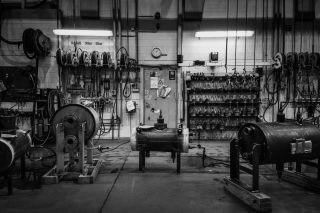LNGenius: Clever Cold Energy Recovery in Spain’s Ports

Enagas is a company with 50 years’ experience of working with the gas supply, both in Spain and globally. It owns and operates the Spanish national gas grid, as well as having a presence in other EU-countries and in Latin America.
With a team of three to five people, e4efficiency is a small department within the giant Enagas corporation. A kind of R&D hub, it tests and develops projects that can be scaled up later. Its projects in progress deal with the production, transport and commercialisation of the cold energy inherent in LNG. While minimising carbon footprints, such cold-harvesting projects also lead to economic savings and bring new businesses to underused port areas, where the LNG is processed.
Vahterus’ first communications with Enagas in general and with e4efficiency in particular began back in 2012. ‘We received very good references about Vahterus products from people in our Bilbao regasification plant, where they have one heat exchanger operating with excellent results’, says Ana M. Azuela Gómez, Project Engineer at e4efficiency. ’Our refrigeration specialist also recommended Vahterus Plate & Shell Heat Exchangers because of their cost, size and operation. We received recommendations from both the regasification and industrial world, so we had no doubt when choosing a heat exchanger.’
Vahterus’ willingness to innovate and experiment was also an important factor: ‘There’s a very good relationship between e4efficiency and Vahterus, not only on a commercial level, but they also help us continuously in new studies and proposals’, says Azuela Gómez. ‘They’re open to researching new exchanges and processes, which is greatly appreciated by an innovative start-up like e4efficiency. We’d also like to highlight the fast response that we receive from Vahterus in all technical aspects.’
From the very beginning, the focus of discussions was on the applications related to the use of LNG. One of the ideas developed between Vahterus and e4efficiency was to utilise cold energy from the vaporisation of LNG. With conventional technologies, this was dumped into the sea, but e4efficiency saw a potential for its use as a source of cheap energy for logistics centres surrounding harbours.
As a result of collaborative thinking, Vahterus and Enagas developed a ‘cold box’ system, which consists of an exchange system and pumps. The pumps propel the refrigerant towards the client’s facilities in a closed loop, at the temperature
they require.

In this system, high-pressure LNG is passed through an exchange system of two Vahterus heat exchangers, one with LNG/intermediate fluid and the other with intermediate fluid/refrigerant fluid. The intermediate fluid circulates between the exchangers through a process of thermosiphon, and through the difference in density between the liquid phase and the gas phase, without the need for pumping. The temperature of both the intermediate fluid and the refrigerant may vary, depending on the needs of the customer. The cold energy of the LNG is recuperated, and can be made available to clients who require it, from refrigerated warehouses and ice factories, to industrial, pharmaceutical customers, data centres, etc. In theory, it will become a trouble-free solution with no risk of freezing the CO2 or the Temper (the refrigerant), since the LNG does not come into direct contact with them, but transfers cold energy through the intermediate fluid.
This idea was first tested with a 35 kW skid from 2018 to 2020, with positive results. The second prototype, with a capacity scaled up to 370 kW, is getting ready for start-up in the coming months in Huelva, Spain. Azuela Gómez remarked: ‘We’ve had a very good experience with the two Vahterus exchangers that we have in the LNG cold-harvesting prototype. Both the LNG / Ethane and the Ethane / Temper systems work perfectly, with an adequate temperature transmission speed and without requiring a cooling curve that’s too slow. Furthermore, during the prototype start-up, two Vahterus technicians were present, which was very helpful for us.’
Having looked at the results of the two test skids, Enagas has begun two ‘full-scale projects this year, amounting to 14MW of cold-energy recovered using this technology: project ‘Barcelona’ and project ‘Huelva’. These are harbour locations in Spain, where Enagas receives LNG from tankers and will be able to develop the surrounding area by attracting companies to move closer to the harbour. In those projects, it is expected that end clients will make 25–40% savings compared to the use of electricity, when moving their facilities closer to the port. And this is just a beginning: with the demand for cold energy increasing around the globe due to global warming, there will be plenty more projects to come.
According to Azuela Gómez, e4efficiency will continue to work with Vahterus: ‘Due to the good results obtained so far, we hope to keep working with Vahterus Plate & Shell Heat Exchangers, even improving on these great results and implementing this technology in new processes with LNG as the protagonist.’
Download the case study as a PDF

Transform your project with Vahterus Expertise
Interested in working with us? Our team of experts are ready to collaborate with you. Contact us today to embark on a journey towards cost-effective, sustainable and energy-efficient heating solutions.
Discover more of our Customer Stories

Cryostar’s Saturation System Transforms Truck-Fuelling Stations
Founded in 1972, Cryostar specialises in designing and manufacturing cryogenic equipment. The company offers turbomachines, gas heaters and vaporisers, pumps, turbines as...

Entering Into Low-Carbon Economy Utilising Cold Energy Recovery
The production of alcohol amines requires large amounts of ethylene. A chemical plant in Eastern China specialises in alcohol amine production. Ethylene...

Global Challenges Drive Innovation at Pannonia Bio’s Ethanol Plant
Pannonia Bio's ethanol plant not only leads in green innovation but exemplifies collaborative success. Since 2012, the company has grown into Europe's...
